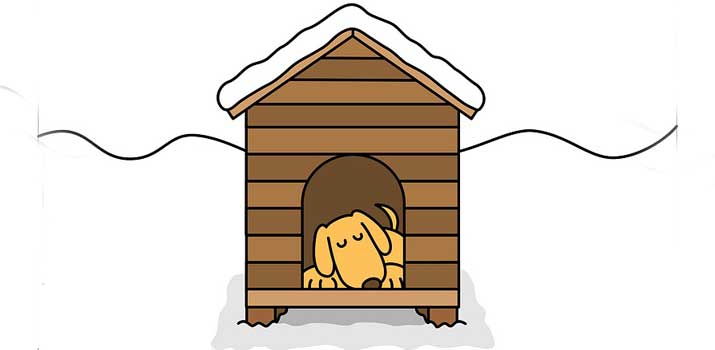
A good dog house can do a lot to beat the cold once the winter season rolls around. Dog houses provide shelter and can block out the frigid wind on those long cold nights.
But there’s one important thing to remember: Dog houses aren’t built to the same standards as your own house! Even premium dog houses aren’t going to provide the same level of protection or warmth.
While there are ways to heat your dog’s domain, modern methods often require electricity. Running an electrical line out to your dog’s house isn’t always a viable option.
In fact, it could pose a bigger safety risk.
So, how do you keep a dog house warm? Well, there are several electric-free approaches to help your dog stay cozy all winter long.
14 Ways to Heat a Dog House Without Electricity
#1. Improve the House’s Insulation
Insulation helps to reduce thermal transfer. During the winter, heat will naturally build up inside the dog house.
This is especially true if your dog is resting inside. Their body heat will increase air temperatures.
But without insulation, that generated warmth will quickly dissipate through thermal transfer.
You can easily solve this problem by adding some insulation to the interior walls of the house. The same fiberglass insulation that you use in your home works great!
Alternatively, you can use foil-backed boards to radiate heat back towards your dog.
Whatever you use, make sure that the insulation is not accessible to your dog.
Sandwich it between the interior and exterior walls for protection. Or, create a false wall to prevent your dog from chewing it up.
Adding insulation is relatively cheap. But, it can make a huge difference.
Don’t just focus on the walls alone!
Add some to the roof as well. After all, heat rises. A lot of the warmth in the house will escape through the roof. So, don’t forget to cover the ceiling as well.
#2. Cover the House in Dark Paint
Most dog houses are either white, off-white, or light brown. While that’s great for aesthetics, it’s not the most conducive for generating heat.
You see, lighter colors reflect heat away. Meanwhile, darker colors absorb it!
Give your dog’s home a nice coat of dark paint.
Black is going to provide the best results. But you can also utilize shades like dark navy blue or deep forest green. Any dark color will work.
Throughout the day, the paint will help to heat the home up. Pair the dark pain with some adequate insulation and the house will stay warmer for much longer.
#3. Eliminate Draft Sources
Don’t expect your dog house to be draft-free. Chances are, there are several cracks or holes that let cool air in.
They could be a product of wear and tear or present by design. For example, you might notice a draft around latching mechanisms or ventilation grates.
When the winter season comes, you need to seal those holes as best as possible.
You can cover grates or ventilation holes with plastic sheeting. Though, a thicker material like insulated foam or wood works best.
For all the tiny holes and cracks, use something like expanding foam. Once you seal the dog house, it can effectively hold heat.
#4. Put the House in the Sun
Sometimes, the best solution is staring right at you!
Putting the dog house in the sun’s path is one of the easiest ways you can generate natural warmth. You’re essentially leveraging the sun’s energy.
While this won’t help at night, it can warm the interior up during the day. If you have insulation, some of the heat will remain after the sun goes down.
Put the home in a part of your yard that gets the most sun exposure. Try to position it so that the flattest side is soaking up the rays.
#5. Install a door
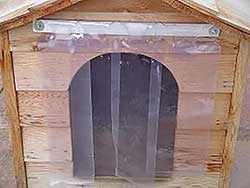
No matter how much insulation you install, it’s not going to do any good unless the opening of the house is sealed.
The opening is where all of the heat will escape. So, you need to install a door to keep things warm.
You don’t have to get super fancy here. There’s no need to install a full swinging or sliding door. In fact, a difficult-to-use door will only make your dog not want to get inside.
Instead, use a plastic flap! Flap-style doors are usually made of thick plastic that falls against the opening. Your dog can easily push through to get inside.
Once they’re in, the plastic will create a seat to keep the warm air in.
#6. Raise the House Off the Ground
This method may not work for everyone. It all depends on where you live and what type of weather you experience.
If you live in a region that frequently experiences frost and snow, the ground probably gets colder than the surrounding air.
In this case, raising the doghouse off the floor could be beneficial. Use a couple of cinder blocks to create some separation.
That extra space will act as a buffer to prevent the soil from pulling warm air away from your sleeping pooch.
Now, if the soil stays relatively warm, raising the house will have the opposite effect. Do some research about the weather in your area before you try this method out.
#7. Add Heat-Retaining Accessories

There’s no shortage of heat-retaining accessories out there. You can invest in water bottles, microwaveable cushions, non-electric heat pads, and more.
If you’re in a pinch, you can even fill a sock up with some rice and pop it in the microwave for a minute or two.
Heat-retaining accessories won’t last throughout the night. They will eventually get cool. But, you can put them in the house after the sun goes down.
With proper insulation, the accessories will warm the house up enough for your dog to stay comfortable as the temperature drops.
#8. Provide Thick Bedding
A thick bed can work wonders in a dog house.
We’re not talking about cheap beds with a thin layer of loose cushion. We’re talking about thick bedding with foam that can hold onto a bit of heat.
A high-quality bed will absorb some heat from your pup’s body as they rest. In turn, the space will become warmer.
While a premium bed is always a good investment, you don’t have to spend a ton of money to provide some additional bedding.
Hay or loose straw is a great economical option that has the same effect as thick foam.
Just line the bottom of the dog house with hay and replace it every day or two.
#9 Add Blankets and Pillows
Don’t be afraid to spoil your dog with several blankets and pillows!
Not only do these nighttime accouterments make your dog feel more comfortable, but they can also raise the temperature inside the dog house.
Like bedding, pillows and blankets will hold onto your dog’s body heat.
#10. Position the House Next to Yours
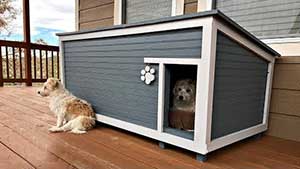
Here’s an option that won’t cost you much. If your dog’s house is out in your open backyard, it’s more exposed to elements.
At night, it’s bombarded by cool temperatures from all directions.
By placing the house next to your home’s exterior wall, you’re providing a lot of natural protection. Your home will serve as a barrier against the wind.
Plus, heat can radiate through the exterior walls to heat up the dog house. The added warmth isn’t significant. But every bit counts.
#11. Place the House Under Additional Shelter
Have a screened-in porch or covered deck? Consider placing the dog house there. Again, it’s all about providing additional protection from the elements.
The less exposure your dog’s house has, the warmer it will be.
#12. Add Radiant Heat
This electric-free technique is not an easy one. But, it can drastically improve the comfort levels in your dog’s house.
You can work with a plumber to run hot water pipes from your home to the dog house. As the hot water passes through, it will naturally heat the air.
Think of it as a standard radiator. If you want to make things more permanent, you can even install a radiator unit.
Running pipes from your home is a more involved project. Also, you have to plan things accordingly to ensure that your dog isn’t burned or exposed to danger.
That said, this is one of the most effective methods out there.
We recommend positioning the house closer to yours first. If you’re able to put the house on the other side of a bathroom or laundry room, you can reduce costs quite a bit.
#13. Connect Your Home with Air Ducts

Here’s another effective heating option. Like the previous method, this one is best if your dog’s home is relatively close to yours.
The goal here is to pipe warm air into the dog house through an air duct.
This is a good choice because you’re essentially extending the heating area of your home. But, there’s no need to run wires or install any electric equipment.
All you need is a foil-lined dryer duct!
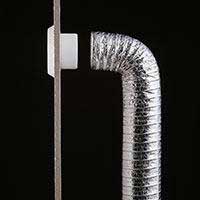
Using a window adapter, connect the duct from your home to the dog house.
If you want to improve efficiency, you can utilize a fan to force air down the duct. But even without a fan, the warm air will make its way to the house to heat it up.
#14. Improve Thermal Mass
Our final tip is to add some thermal mass to the dog house. This can be a bit tricky and costly, but it does a lot to improve the structure’s ability to retain heat.
When you add thermal mass, you’re using heavy and dense materials. You can add these materials to the exterior of the home or line the walls.
Materials like concrete cinderblocks and bricks are suitable choices. Make sure that you’re installing these materials permanently.
Piling a layer of bricks outside of the house won’t do any good.
They have to be attached to the structure so that they can hold onto heat and warm the interior.
Why Avoid Electricity?
There’s nothing inherently wrong with using electricity to heat a dog house. Many electric-based heating methods will do a better job of providing warmth for your pooch than non-electric methods.
But, you may encounter some problems that will prevent you from using electricity.
Many jurisdictions have strict laws about running electric lines to the backyard.
The occasional extension cord is usually no problem. But some municipalities aren’t keen on allowing them throughout the winter.
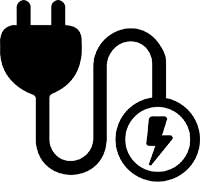
Plus, there’s the matter of safety. If you have a rambunctious dog that likes to chew on everything, you should avoid exposed electrical lines at all costs.
Dogs don’t know any better and will chew right through them, creating a big safety risk.
If you have a well-mannered dog and the means to run an electric line to a dog house, by all means, do so! But these electric-free methods can get the job done safely and efficiently.
Effective Electric Heating Options
Looking for some heating methods with more impact? Electric-based heating can provide greater results. But before you try them out, make sure to check with your local laws and consider your dog’s behavior.
Heated Pads and Kennel Mats
Nothing beats a heated pad!
These accessories look like your average bed or kennel mat. But, they’re hiding some heating coils that run throughout the cushioning.
Most come with a small control panel that you can use to set the temperature or turn on a timer. In only a few minutes, the mat will generate soothing radiant heat!
You can also get larger bed-style models that can wrap your dog in warmth.
Dedicated Heater
Did you know that you can get a dedicated heating and cooling system for a dog house?
They operate just like your home’s system. However, they’re much smaller.
These systems aren’t cheap by any means. But if you want to spoil your pooch, they are the best option around.
They do require extension installation. Depending on the design, you might have to install small ducts as well.
Electric Space Heaters
Small space heaters are a great choice. Most are portable and don’t take up a ton of space.
Like heating pads, they can warm up the dog house in only minutes. Not only that, but they can maintain the temperature all night long.
The only caveat here is that you have to be careful about where you place it.
Space heaters can get very hot. If knocked over, they can also present a fire hazard. Make sure that the heater is out of reach and secure before turning it on.
Solar Heating Systems
Solar heating systems are the best of both worlds! They require some wiring and have electrical components. But, they are completely independent of your home.
You can install solar panels on the roof of the house. With a converter and battery, the system will provide enough energy to power a small mounted heater inside.
Conclusion
If your dog lives outside, providing heat during the winter is a must. Your pup’s dog house needs to be a warm haven that they can escape to when the temperature drops.
While electrical heating systems offer the most efficiency, there are plenty of ways to provide warmth without them!
The key is to create the most heat-efficient home possible. Using these methods, you can take advantage of natural sources of heat to help your dog stay cozy no matter what.
Also Read: 5 Best rated Outdoor Dog Houses For Warm / Hot Summers

